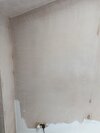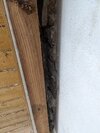Hi,
I recently had a room totally re-done. It was gutted and stripped all the way back to brick and built back out.
The plastering was completed around 4 or 5 weeks ago and the house hasn't been heated during that time. In the room, the vast majority of the plaster appears dry. On one of the external walls, there are some damp patches that have never gone away and they appear to have a kind of white residue on as well (salt?). There's also a bit of staining/damp around the plug socket that's on that wall.
I wasn't involved in the build process that much but I think the boards could have been dot and dabbed on that wall directly on to the brick. I also believe the plasterboard is the insulated type.
The builder assures me this is normal and it will dry out but I'm not so sure. Anyone seen this before? Is it the dabs wicking the water through from the brickwork? Bit disappointed if this is the case as it would have been much easier to fix when the room was a shell a few months ago...
Pictures attached showing the stains (There are more that are similar and not in the picture) and also a close-up of one. It has some pencil lines on it, doesn't seem to be getting any bigger.
Thanks
I recently had a room totally re-done. It was gutted and stripped all the way back to brick and built back out.
The plastering was completed around 4 or 5 weeks ago and the house hasn't been heated during that time. In the room, the vast majority of the plaster appears dry. On one of the external walls, there are some damp patches that have never gone away and they appear to have a kind of white residue on as well (salt?). There's also a bit of staining/damp around the plug socket that's on that wall.
I wasn't involved in the build process that much but I think the boards could have been dot and dabbed on that wall directly on to the brick. I also believe the plasterboard is the insulated type.
The builder assures me this is normal and it will dry out but I'm not so sure. Anyone seen this before? Is it the dabs wicking the water through from the brickwork? Bit disappointed if this is the case as it would have been much easier to fix when the room was a shell a few months ago...
Pictures attached showing the stains (There are more that are similar and not in the picture) and also a close-up of one. It has some pencil lines on it, doesn't seem to be getting any bigger.
Thanks








